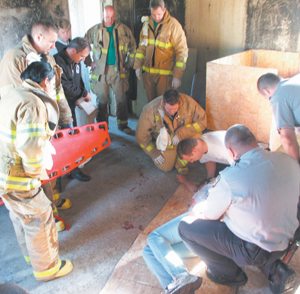HEROES OF THE FLAME

“I would say about eighty percent of our weekly calls are not fire-related,” says Lieutenant Todd Prindle of Station 14. “We tend to do more vehicle crashes and medical assisting than fire rescue, but we have been trained for most scenarios. There are certain books that we have to study in order to become firemen and it takes some time, but it’s definitely worth it.” The actual process of becoming a fireman takes approximately nine months to complete, which is a long application process for a job.
Personally, I cannot comprehend being both physically and mentally able to last that long, having just completed a few of the many training scenarios at the Fort Wayne Fire Department Training Academy (located in downtown Fort Wayne). Always wanting to fulfill my childhood dream of becoming a fireman, I volunteered to put on the suit and mask and go through a few basic stations that simulated a fraction of the actual job description.
The first day, I was greeted with a hearty pizza lunch by many local firemen and introduced to the objectives ahead. After the background history of fire fighting and a brief rundown of what I was to be doing the next day, I was fitted for my equipment. Just the sheer physical endurance required to be able to carry 65lbs. worth of items on your body demands respect. I had on a helmet, a thick fire-retardant jacket and pants, fire-resistant boots, heat-treated gloves, a protective hood, a breathing mask and finally a breathing apparatus that alone weighed about 30lbs. Merely standing around with my full suit on made me sweat, and yet at the same time made me shiver knowing what all firefighters have to go through with all the gear on and running. I was nervous about the day to come, but eager nevertheless.
Upon arriving at 7:30 am the next morning, I was greeted once again by friendly firefighters and a continental breakfast provided by the station. After eating, I was directed to a physician who needed to take our vitals for safety reasons. Apparently, they did not want anyone who was too nervous or too low in blood pressure to participate in the day’s events. Being in the normal range, I was excited to learn that I was finally able to suit up and head out to one of the four simulation stations.
It is at this point in my story that I should note that all of these stations were in a controlled environment and kept under a watchful eye by numerous firefighters so that I did not put myself (or any others) in danger.
The first exercise consisted of Prindle and me carrying a fire hose into a living room-type setting that had caught fire. Chairs and sofas were placed in a specific pattern so that the environment simulated a common family house based around a fireplace, which had gotten out of hand. I had a team of fellow participants feeding me the hose as Prindle and I crawled to the source of the smoke with hopes of putting out the fire. Even with all of my fire protection on, I could certainly feel the heat. I tried not to panic from being in this situation, but this was not a natural event for me to be doing, so naturally I was overly nervous. With the help of Prindle, I managed to hold onto the forceful hose and douse the flames. After crawling out of this exercise, I was exhausted. Lieutenant Todd Prindle, aside from the heat, had barely broken a sweat. For firefighters, this sort of exercise is just the tip of the iceberg (and possibly the easiest). Following the first exercise was a required rest period of approximately 15-20 minutes. This allowed us to re-hydrate and refuel our bodies with the energy lost during the event. We were definitely going to need it for the next station.
While still wearing our protective suits, our next objective was to climb four stories up a building and assist a medical team who was already caring for an “injured person” (she was a live patient conducting a simulation of being injured). Although I was not wearing the breathing apparatus, I still had around 35lbs. of extra weight holding me back as I went up the stairs. Needless to say, the hike was grueling. After arriving at the top, we took note of how the medical team approaches the injured and assisted them in lifting the patient out of a four-story window onto the fire truck’s ladder. This exercise was not so much physically demanding as the last, but was certainly more mentally challenging. I had to be well aware of my surroundings while carrying the patient out the window because one wrong step and we could drop the person down four flights of stairs or out the four-story window. The actual fire crew around me was highly professional (even during a simulation) and one couldn’t help but to feel safe knowing that these men and women were so dedicated and serious about their jobs. After another rest period, an analysis of what we just did, and the significance of how this exercise applies to real-life occurrences, we once again got ready for the next station.
This exercise required us to be in full uniform plus the breathing apparatus. We were prompted to pick up an axe, climb a ladder onto a roof (a model scaled down to about a quarter the size of a real house’s roof) and chop a whole into a sheet of wood that simulated the necessity of ventilation. This step is done during a real-life house fire in order to ventilate a house, and keep it from becoming too smoky. If the house is too smoky, then the firefighters cannot see well enough to rescue whoever may be inside. Once I approached the prime chopping position on top of the roof, I started hacking away at the board until I grew tired. With 60lbs. of additional weight clinging to your body, you have less than half the mobility and endurance of your normal lifestyle. This proved to be quite true in my situation because I was unable to actually chop through the board before I began to feel light-headed. I climbed off the ladder and went to sit down. But, before I could, I was stopped by a medical personnel saying that I was losing color in my face very fast. Apparently I was about to faint from exhaustion because I was carried off to the ambulance to be given oxygen and a blood pressure test. I was then informed that my blood sugar was way too low and that I needed to eat something quick to restore my energy. One banana and a glass of orange juice later, and I was ready to move on to the next station.
“This is one of the worst feelings to have while going on calls. When you wake up in the morning to the fire alarm going off, you don’t have time to eat. Naturally your blood sugar is going to be low throughout the entire trip, so this leads us to feeling nauseous and weak until we can get something in our stomachs,” comments Lieutenant Prindle. However, these strong heroes still press on with the intention to help others before themselves.
My final station to complete was, in my opinion, the most challenging out of all the events because it required us to be calm, regulate our breathing and be still while having to sit through 15 minutes of extreme temperatures. The area of our simulation began in a small room lined with one foot-wide benches to sit on. As we sat on those benches, we remained motionless while the air became smothered with dark smoke and the temperature rose to around 280 degrees. Unfortunately, I was unable to complete this exercise because I was stricken with a panic attack and had to be removed from the area. Lieutenant Todd Prindle remained inside with the others and was like a motionless statue. After reaching fresh air, I was informed that the area within the simulation directly next to us (the area with the fire) grew to a temperature of around 775 degrees. Lieutenant Prindle just chuckled.
“This sort of situation is pretty mild compared to the temperatures you would see in most fires fought. Plus, the smoke we encounter will sometimes be pitch black, making things even harder to see.” After feeling quite down on myself about not finishing the exercise, he explained to me that not all people are able to do what I just attempted. “We have seen men and women in the academy go through this exercise and not be able to complete it. It’s not for everyone.”
There was never a moment in my life where I had ever felt so much pride. I had finally completed these stations with barely enough strength to stand up, let alone go out and do it all over again (like many of these firemen would do during weekly calls). I felt tired, sweaty, weak and hungry. However, and above all else, I felt so much respect for these people doing this on a daily basis.
What we as a community need to realize is that these men and women of the Fire Department are those of an elite part of our government. They willingly put others before themselves without a moment’s hesitation. Whether it be rescuing a kitten from a tree, putting out a house fire, or rushing to the scene during 9/11, these people are my heroes…they are America’s heroes.
- Celebrating 20 Years Of Community At The Stand - April 12, 2024
- First Positive Case Of Chronic Wasting Disease In Indiana - April 12, 2024
- Southwest Allen County Schools Embark On Major Tree Plantings - April 12, 2024


